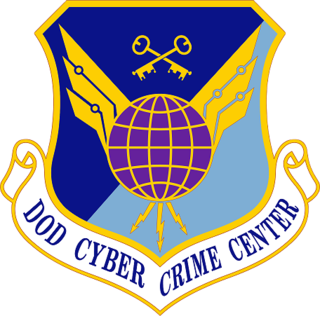
Computer security is the protection of computer systems and networks from threats that may result in unauthorized information disclosure, theft of hardware, software, or data, as well as from the disruption or misdirection of the services they provide.
Information warfare (IW) is the battlespace use and management of information and communication technology (ICT) in pursuit of a competitive advantage over an opponent. It is different from cyberwarfare that attacks computers, software, and command control systems. Information warfare is the manipulation of information trusted by a target without the target's awareness so that the target will make decisions against their interest but in the interest of the one conducting information warfare. As a result, it is not clear when information warfare begins, ends, and how strong or destructive it is.
Cyberterrorism is the use of the Internet to conduct violent acts that result in, or threaten, the loss of life or significant bodily harm, in order to achieve political or ideological gains through threat or intimidation. Emerging alongside the development of infomration technology, cyberterrorism involves acts of deliberate, large-scale disruption of computer networks, especially of personal computers attached to the Internet by means of tools such as computer viruses, computer worms, phishing, malicious software, hardware methods, and programming scripts can all be forms of internet terrorism. Some authors opt for a very narrow definition of cyberterrorism, relating to deployment by known terrorist organizations of disruption attacks against information systems for the primary purpose of creating alarm, panic, or physical disruption. Other authors prefer a broader definition, which includes cybercrime. Participating in a cyberattack affects the terror threat perception, even if it isn't done with a violent approach. By some definitions, it might be difficult to distinguish which instances of online activities are cyberterrorism or cybercrime.

The United States Strategic Command (USSTRATCOM) is one of the eleven unified combatant commands in the United States Department of Defense. Headquartered at Offutt Air Force Base, Nebraska, USSTRATCOM is responsible for strategic nuclear deterrence, global strike, and operating the Defense Department's Global Information Grid. It also provides a host of capabilities to support the other combatant commands, including integrated missile defense; and global command, control, communications, computers, intelligence, surveillance, and reconnaissance (C4ISR). This command exists to give "national leadership a unified resource for greater understanding of specific threats around the world and the means to respond to those threats rapidly".

Cyberwarfare is the use of cyber attacks against an enemy state, causing comparable harm to actual warfare and/or disrupting vital computer systems. Some intended outcomes could be espionage, sabotage, propaganda, manipulation or economic warfare.
The Joint Worldwide Intelligence Communication System is the United States Department of Defense's secure intranet system that houses top secret and sensitive compartmented information. JWICS superseded the earlier DSNET2 and DSNET3, the Top Secret and SCI levels of the Defense Data Network based on ARPANET technology.

The 1st Information Operations Command (Land), formerly the Land Information Warfare Activity Information Dominance Center (LIWA/IDC), is an information operations unit under the operational control of U.S. Army Cyber Command (ARCYBER) and headquartered at Fort Belvoir, Virginia.
A cyber force is a military branch of a nation's armed forces that conducts military operations in cyberspace and cyberwarfare. The world's first independent cyber force was the People's Liberation Army Strategic Support Force, which was established in 2015 and also serves as China's space force. As of 2022, the world's only independent cyber forces are the PLA Strategic Support Force, the German Cyber and Information Domain Service, Norwegian Cyber Defence Force, and the Singapore Digital and Intelligence Service.
Beginning on 27 April 2007, a series of cyberattacks targeted websites of Estonian organizations, including Estonian parliament, banks, ministries, newspapers and broadcasters, amid the country's disagreement with Russia about the relocation of the Bronze Soldier of Tallinn, an elaborate Soviet-era grave marker, as well as war graves in Tallinn. Most of the attacks that had any influence on the general public were distributed denial of service type attacks ranging from single individuals using various methods like ping floods to expensive rentals of botnets usually used for spam distribution. Spamming of bigger news portals commentaries and defacements including that of the Estonian Reform Party website also occurred. Research has also shown that large conflicts took place to edit the English-language version of the Bronze Soldier's Wikipedia page.
Proactive cyber defense, means acting in anticipation to oppose an attack through cyber and cognitive domains. Proactive cyber defense can be understood as options between offensive and defensive measures. It includes interdicting, disrupting or deterring an attack or a threat's preparation to attack, either pre-emptively or in self-defence.

The Department of Defense Cyber Crime Center (DC3) is designated as a Federal Cyber Center by National Security Presidential Directive 54/Homeland Security Presidential Directive 23, as a Department of Defense (DoD) Center Of Excellence for Digital and Multimedia (D/MM) forensics by DoD Directive 5505.13E, and serves as the operational focal point for the Defense Industrial Base (DIB) Cybersecurity program. DC3 operates as a Field Operating Agency (FOA) under the Inspector General of the Department of the Air Force.

United States Cyber Command (USCYBERCOM) is one of the eleven unified combatant commands of the United States Department of Defense (DoD). It unifies the direction of cyberspace operations, strengthens DoD cyberspace capabilities, and integrates and bolsters DoD's cyber expertise which focus on securing cyberspace.
Cyberwarfare is the use of computer technology to disrupt the activities of a state or organization, especially the deliberate attacking of information systems for strategic or military purposes. As a major developed economy, the United States is highly dependent on the Internet and therefore greatly exposed to cyber attacks. At the same time, the United States has substantial capabilities in both defense and power projection thanks to comparatively advanced technology and a large military budget. Cyber warfare presents a growing threat to physical systems and infrastructures that are linked to the internet. Malicious hacking from domestic or foreign enemies remains a constant threat to the United States. In response to these growing threats, the United States has developed significant cyber capabilities.
The 2011 U.S. Department of Defense Strategy for Operating in Cyberspace is a formal assessment of the challenges and opportunities inherent in increasing reliance on cyberspace for military, intelligence, and business operations. Although the complete document is classified and 40 pages long, this 19 page summary was released in July 2011 and explores the strategic context of cyberspace before describing five “strategic initiatives” to set a strategic approach for DoDʼs cyber mission.

The U.S. Fleet Cyber Command is an operating force of the United States Navy responsible for the Navy's information network operations, offensive and defensive cyber operations, space operations and signals intelligence. It was created in January 2010 "to deter and defeat aggression and to ensure freedom of action to achieve military objectives in and through cyberspace". U.S. Tenth Fleet was simultaneously reactivated as its force provider. Since it was founded, the command has grown into an operational force composed of more than 16,000 active and reserve sailors and civilians organized into 27 active commands, 40 Cyber Mission Force units, and 27 reserve commands around the world.
A Master of Science in Cyber Security is a type of postgraduate academic master's degree awarded by universities in many countries. This degree is typically studied for in cyber security. What is offered by many institutions is actually called a Master in Strategic Cyber Operations and Information Management (SCOIM) which is commonly understood to be a Master in Cybersecurity. This degree is offered by at least some universities in their Professional Studies program so that it can be accomplished while students are employed - in other words it allows for "distance learning" or online attendance. Requirements for the Professional Studies program include: 3.0 or better undergrad GPA, professional recommendations letters and an essay.

Gabriel "Gabi" Siboni is a colonel in the Israel Defense Forces Reserve service, and a senior research fellow and the director of the Military and Strategic Affairs and Cyber Security programs at the Institute for National Security Studies. Additionally, he serves as editor of the tri-yearly published, Military and Strategic Affairs academic journal at INSS. Siboni is a senior expert on national security, military strategy and operations, military technology, cyber warfare, and force buildup. Siboni is an Associate Professor, working specifically in the management of Cyber Security and a part-time lecturer at the Francisco de Vitoria University in Madrid

The Joint Cyberspace Command (MCCE), known until 2020 as Joint Cyber-Defence Command (MCCD), is a Spanish cyberspace service of the Defence Staff responsible for planning and carrying out the actions related to cyber defence in networks and information and telecommunications systems of the Ministry of Defense or others that might be entrusted, as well as contributing to the adequate response in cyberspace to threats or aggressions that may affect to the National Defense.
Operational collaboration is a cyber resilience framework that leverages public-private partnerships to reduce the risk of cyber threats and the impact of cyberattacks on United States cyberspace. This operational collaboration framework for cyber is similar to the Federal Emergency Management Agency (FEMA)'s National Preparedness System which is used to coordinate responses to natural disasters, terrorism, chemical and biological events in the physical world.










